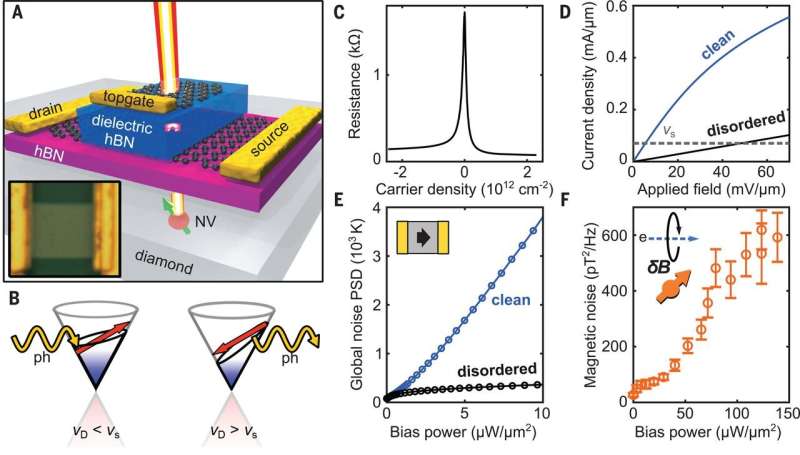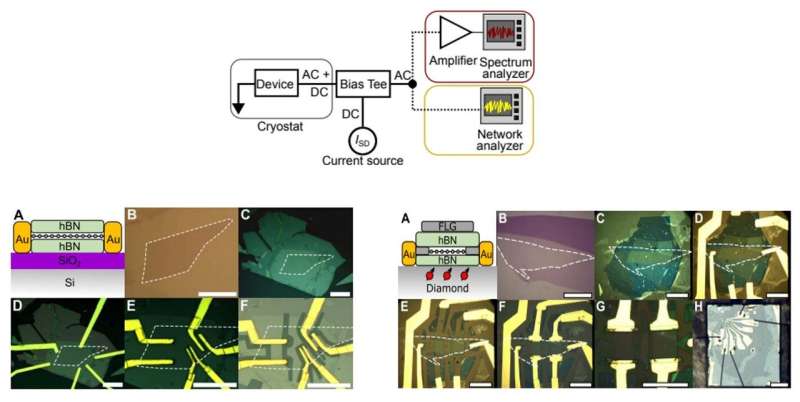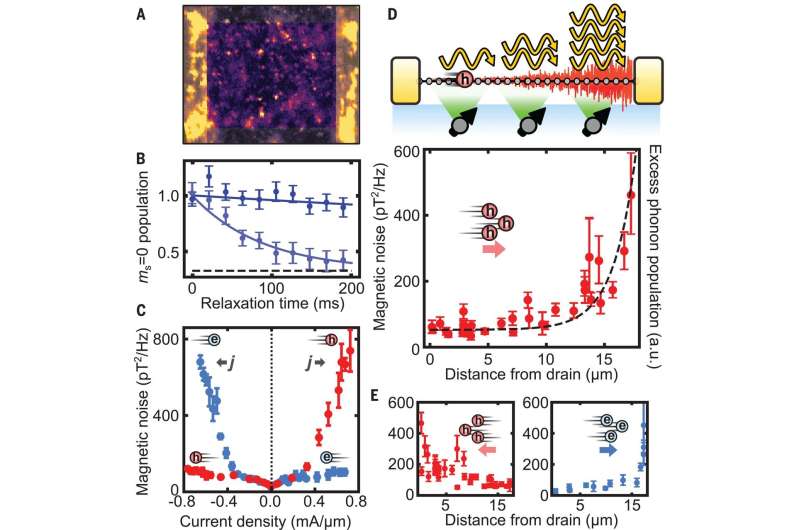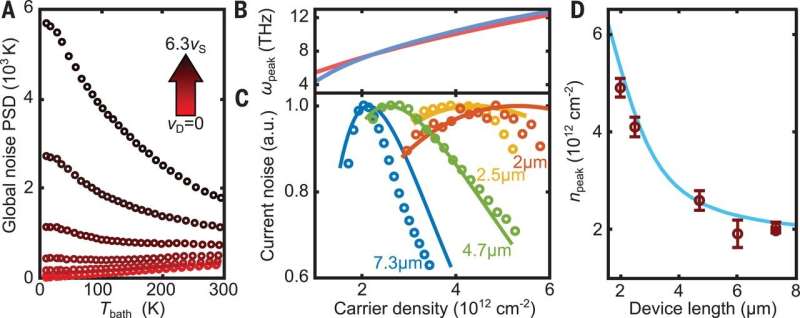April 23, 2019 feature
Electron-phonon instability in graphene revealed by global and local noise probes

Understanding nonequilibrium phenomena to effectively control it is an outstanding challenge in science and engineering. In a recent study, Trond. I. Andersen and colleagues at the departments of physics, chemistry, materials science and engineering in the USA, Japan and Canada used electricity to drive ultraclean graphene devices out-of-equilibrium and observe the manifested instability as enhanced current fluctuations and suppressed conductivity at microwave frequencies.
Using the experimental setup, they found that direct current at high drift velocities generated a large increase in the noise at gigahertz frequencies and the noise grew exponentially in the direction of the current. Andersen and co-workers credited the observed emission mechanism, to the amplification of acoustic phonons by the Cerenkov effect (a characteristic blue glow resulting from charged particles passing through an insulator at a speed greater than the speed of light in that medium) and have now published the results on Science.
The scientists spatially mapped the nonequilibrium current fluctuations using nanoscale magnetic field sensors to reveal that they grew exponentially along the direction of carrier flow. Andersen et al. credited the observed dependence of the phenomenon on density and temperature, to electron-phonon Cerenkov instability at supersonic drift velocities. Supersonic drift velocities occurred when the population of certain phonons increased with time due to forced Cerenkov emission, when the drift velocity of electron conduction was greater than the velocity of sound (VD>VS) in the medium. The experimental results can offer the opportunity to generate tunable terahertz frequencies and construct active phononic devices on two-dimensional materials.
Nonequilibrium phenomena driven in electronic and optical systems display rich dynamics, which can be harnessed for applications as Gunn diodes and lasers. Two-dimensional materials such as graphene, are an increasingly popular new platform to explore such phenomena. For instance, modern ultraclean graphene devices demonstrate high mobilities and can be driven to high electronic velocities with predicted instabilities to include hydrodynamic instabilities in electronic fluids and Dyakonov-Shur instabilities where the driven electrons can amplify plasmons.

The study of electronic properties of graphene under extreme nonequilibrium conditions therefore provides a productive testbed to assess and monitor exotic transport phenomena. In addition to the use of high-frequency signal generation, Andersen et al. investigated the underlying non-equilibrium dynamics during electron transport in ultraclean graphene devices containing an extremely high electron drift velocity. Understanding nonequilibrium dynamics is vital for many technical applications of graphene; including high frequency transistors, ultrafast incandescent light sources and flexible transport interconnects. However, it is difficult to realize the electronic stabilities in practice, due to increased phonon scattering at high drift velocities.
In principle, while phonon scattering loss is typically irreversible, long-lived phonons can act as a dominant source of instability within the experimental setup. When the electronic drift velocity (VD) exceeds the velocity of sound (VS), phonon emission becomes greater than phonon absorption, resulting in an exponential growth of the phonon population, known as phonon Cerenkov amplification. The phenomenon was long explored in theory as a technique to produce high-frequency acoustic waves, with accompanying experimental evidence in bulk systems and semiconductor superlattices obtained using acoustic and optical measurements thereafter.

In the present work, Andersen et al. used electrically gated graphene devices fabricated on diamond and silicon/silicon dioxide substrates, encapsulated in hexagonal boron nitride (hBN) at cryogenic temperatures (T= 10 to 80 K) to conduct the proposed experiments. The experimental setup provided low-bias transport properties for the ultraclean graphene system with a mobility ranging from 20 to 40 m2/V.s at a carrier density (2 x 1012 cm-2), corresponding to nearly ballistic transport. Due to high mobility, carriers could be accelerated by an electric field to high drift velocities to observe nonlinear current response, while a disordered device contrastingly showed linear ohmic behavior.
To study the nonequilibrium behavior, first, Andersen et al. measured the global noise in the source-drain current with a spectrum analyzer, while varying the applied bias power (P). The results indicated a new source of noise in graphene devices with low disorder, encapsulated in hBN. To gain insight to the observed anomaly, the scientists performed spatially resolved noise measurements by constructing graphene devices on diamond substrates with shallow nitrogen-vacancy color-center impurities of 40 to 60 nm in depth. They measured the atom-like spin qubits using confocal microscopy and probed the nanoscale current noise by measuring the resulting magnetic fields.
Andersen et al. probed the spatial dependence of the anomalous noise by optically observing single NV centers along the device to measure their spin relaxation rate . The noise exhibited clear symmetry with the direction of the current, an unexpected outcome since global noise and transport properties are independent of the direction of the current. Then using the device gate, Andersen et al. demonstrated that the local noise signal depended on the flow direction of momentum and not charge. The scientists also showed that the noise was small at the carrier entry point but grew exponentially as the carrier flowed across the 17-µm long device.
![Slow dynamics in global electronic measurements. (A) Global noise spectra at n = 2 × 1012 cm−2. Colored curves: clean device A2 (9.5 μm by 11 μm) at bias ranging from 0 to 0.8 V (bottom to top). Black curve: disordered device B1 at maximum power applied to device A2 (scaled 7×). (B) Ac differential conductivity spectra (excitation: −20 dBm) (19) with biases 0 to 0.8 V [top to bottom, colors same as in (A)]. The real (Re) component is suppressed at low frequencies. Gray curve: imaginary (Im) component at 0.8 V. Black curves are fits. (C and D) Features in noise and conductivity spectra shift to higher frequencies in a shorter (6-μm) device (device A1) under similar electric field as maximum in (A) and (B). (E and F) Extracted traversal time from (B) and (D) as a function of drift velocity and device length. Dashed curves correspond to speed of sound in graphene [light gray, transverse acoustic (TA); dark gray, longitudinal acoustic (LA)]. (G) Cartoon of important rates in the driven electron-phonon system. During Cerenkov amplification, the correlation time observed in electronic measurements is limited by the phonon traversal time, tT=L/vs. Credit: Science, doi: 10.1126/science.aaw2104 Electron-Phonon instability in graphene revealed by global and local noise probes](https://scx1.b-cdn.net/csz/news/800a/2019/3-electronphon.jpg)
The scientists consistently explained all observations using the electro-phonon Cerenkov instability. As a key insight of the study, Andersen et al. showed that when the electronic drift velocity exceeded the speed of sound (supersonic drift velocity), the forward-moving acoustic phonons experienced a faster rate of simulated emission than absorption. Pristine graphene also exhibited long acoustic phonon lifetimes; therefore, an emitted phonon could stimulate the emission of exponential growth in the setup.
When they modelled these effects mathematically, the results agreed well with experimental outcomes, while the anomalous noise further increased with increasing device length. The model predicted that the observed electron-phonon instability would give rise to a conductivity spectrum. The scientists continued to explore the nonequilibrium dynamics using models of the electron-phonon system.

Since the Cerenkov amplification is sensitive to the phonon lifetime, the scientists expected the effects to intensify at lower temperatures due to slower anharmonic decay. However, as Andersen et al. reduced the temperature from 300 to 10 K, they observed a strong increase in noise – in clear contrast to the decreasing thermal noise observed at low drives (vD≲vs), suggesting that the amplification process was limited by scattering with thermally occupied modes.
In this way, Andersen et al. extensively detailed how nonequilibrium dynamics stemming from electron-phonon instability could be demonstrated in a 2D material. In the experiments, the driven electron-phonon system showed rich nonequilibrium dynamics that merit further investigations using new techniques to directly characterize the phonon spectrum and gain further insights. Previous theoretical studies had predicted amplified phonons in graphene with frequencies as high as 10 THz, substantially higher than those in several other materials.
The experimental system can offer pure electrical generation and phonon amplification in a single micrometer-scale device with wide frequency tunability. Andersen et al. envision applications that will explore coupling to a mechanical cavity to develop a phonon laser, and outcoupling of the amplified sound waves to far-field terahertz radiation for medical imaging and security screening imaging (due to the degree of imaging transparency offered), wireless communications, quality control and process monitoring in manufacturing applications. The results by Andersen et al. represent a promising step towards the development of new-generation active phononic and photonic devices for multidisciplinary applications in future work.
More information: 1. Electron-phonon instability in graphene revealed by global and local noise probes DOI: 10.1126/science.aaw2104 , science.sciencemag.org/content/364/6436/154 Trond I. Andersen et al. 12 April 2019, Science.
2. Cerenkov emission of terahertz acoustic-phonons from graphene aip.scitation.org/doi/abs/10.1063/1.4808392 C.X. Zhao et al. 2013, Applied Physics Letters.
3. Nanoscale magnetic sensing with an individual electronic spin in diamond www.nature.com/articles/nature07279 J.R. Maze et al. 2008, Nature.
4. Acoustic amplification in semiconductors and metals www.tandfonline.com/doi/abs/10 … 7?journalCode=tphm19 A.B. Pippard, 1962, The Philosophical Magazine: A Journey of Theoretical Experimental and Applied Physics.
Journal information: Science
© 2019 Science X Network





















